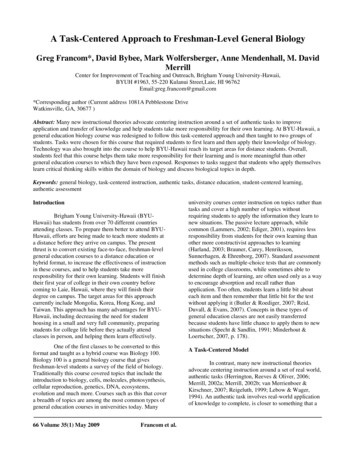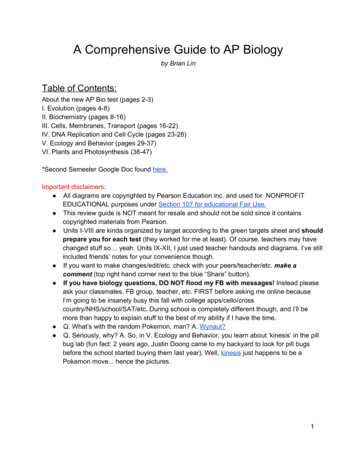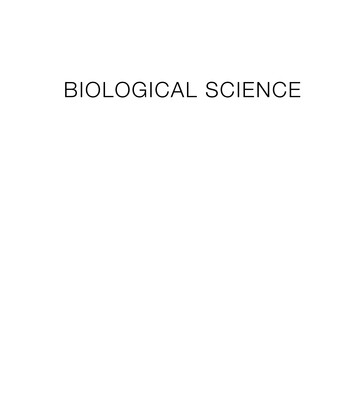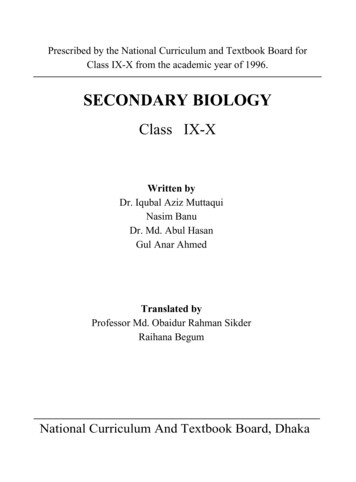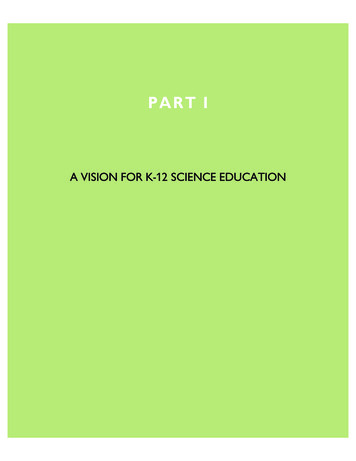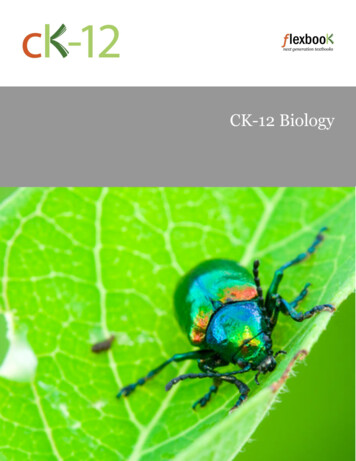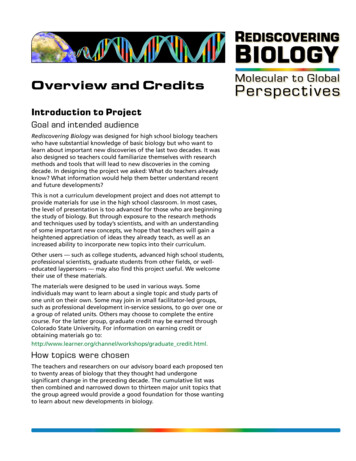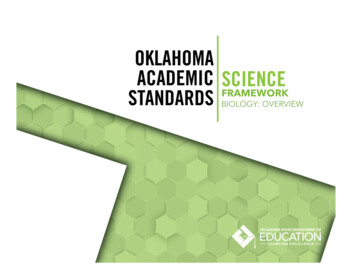
Transcription
FRAMEWORKBIOLOGY: OVERVIEWPage1
The Oklahoma State Department of Education is excited to announce the release of the first resources being offered through theOklahoma Academic Standards Science Frameworks. The Science Frameworks represent curricular resources developed by Oklahomateachers to help teachers translate standards into classroom practice. The Framework Overviews represent how a group of Oklahomateachers, at a given grade level, might bundle performance expectations/standards found in the Oklahoma Academic Standards forScience.1 Bundling is how teachers would group performance expectations/standards for the purpose of developing instructionalunits of study.Once bundled, the Science Framework writers were then charged with completing four categories of information that coincidedwith the bundle of performance expectations/standards. The categories provide insight into how the Science Framework writerscollaborated to begin to translate standards into classroom instruction. The guidance provided in the categories does not represent adirective to teachers, schools or districts for classroom instruction and should not be viewed as such.The Oklahoma State Department of Education would like to say a special thank you to the Oklahoma educators who participated indeveloping the Oklahoma Science Framework Overviews, Doug Paulson of the Minnesota State Department of Education who servedas a consultant, Lawton Public Schools and to Quentin Biddy, the project director.Science Framework WritersSolomon BayouthElizabeth BeckColleen BennettRachel BrownRandi ButcherMegan CannonMandi CloudBenjamin CottinghamJennifer CrabbMaria HarrisWendy HowardTraci RichardsonGeorgia SmithStacey StapeltonAmy TankersleyJenny ThompsonSarah VannMegan VeldhuizenTammy WillSusan Wray“The vision of the Overviews is to provide a resource for teachers that encourages them to embrace the newstandards and implement them effectively in their classrooms. The suggestions provided by the frameworksproject do not have to be implemented exactly as they are written and are not required to be a successfulteacher, but serve as a guide to setting up effective lessons that will help students meet the necessary levelsof success in a science classroom.” - Oklahoma Science Framework Project Writer1Download the Oklahoma Academic Standards for Science at http://sde.ok.gov/sde/science.Page2
How To Read This DocumentBelow you will find short descriptions about each of the sections of information provided in this document. If you have questionsregarding the Framework Overviews, please contact Tiffany Neill at 405-522-3524 or Tiffany.Neill@sde.ok.govScience Framework Overview: SectionsIn Lay TermsThis section aims at providing a brief introduction to the goals outlined in the Performance Expectation Bundles/grouping of standards.Three Dimensional StorylineThis section aims at providing a comprehensive instructional storyline of how the three dimensions represented in the Performance ExpectationBundles intertwine to support students engaging in science and engineering practices, crosscutting concepts and disciplinary core ideas. Keep inmind each performance expectation includes one science and engineering practice, one crosscutting concept and one disciplinary core idea.The color-coding in this section allows teachers to see where components of these three dimensions appear in the instructional storyline. To findout more about the three dimensions and how they are incorporated into the Oklahoma Academic Standards for Science, review pages 7-8 in theOklahoma Academic Standards for Science2 or check out the OKSci PD on Your Plan Module series, Transitioning to the Oklahoma AcademicStandards for Science3.Lesson Level Performance ExpectationsThis section aims at providing scaffolding three-dimensional learning targets that teachers can design instruction around to meet the end goalsof the Performance Expectation(s) represented in the bundles or units of study. Keep in mind the performance expectations represent the thingsstudents should know, understand and be able to do to show proficiency at the end of instruction they participate in. A teacher can utilize theLesson Level Performance Expectations in each bundle as a way to develop a series of instruction to meet the end goals of the performanceexpectations. For example, a teacher can develop or use a lesson, which may allow students to participate in instruction that covers some of theLesson Level Performance Expectations, but not all. In this case the teacher would then develop or conduct another lesson that covers otherLesson Level Performance Expectations in the bundle.MisconceptionsThis section aims at providing research-based misconceptions that students frequently have related to the science concepts (disciplinary coreideas) embedded in the Performance Expectation Bundles along with matching correct conceptions.23Download the Oklahoma Academic Standards for Science at http://sde.ok.gov/sde/science.Access the OKSci PD on Your Plan Modules at: KeJjqS-R8gwwPage3
Bundle: AdaptationsHS-LS2-8Students who demonstrate understanding can:Evaluate evidence for the role of group behavior on individual and species’ chances to survive and reproduce.HS-LS4-4Students who demonstrate understanding can:Construct an explanation based on evidence for how natural selection leads to adaptation of populations.HS-LS4-5Students who demonstrate understanding can:Synthesize, communicate, and evaluate the information that describes how changes in the environmental conditions can affect thedistribution of traits in a population causing: 1) increases in the number of individuals of some species, 2) the emergence of new speciesover time, and 3) the extinction of other species.In Lay TermsOver the course of time, species with traits or characteristics that are better suited for them to survive in a habitat, are likely to have more successthan those that have traits or characteristics that are less suited to a habitat. When an organism has a trait that makes it better suited to theenvironment, it is called an adaptation. An adaptation is a mutation, or genetic change, that helps an organism, such as a plant or animal, survivein its environment. Due to the helpful nature of the mutation, it is passed down from one generation to the next. As more and more organismsinherit the mutation, the mutation becomes more prevalent in the population. The mutation has become an adaptation. Adaptive traits can bephysical or behavioral. Social or group behaviors often develop in populations as a way to overcome limiting factors. For example, herdingbehavior has developed in many prey species. Herding increases the chance of the individual animal to survive a predator’s attack and has thusdeveloped as an adaptation to predators in their environment.Three Dimensional StorylineAdaptation is the primary mechanism by which changes in biodiversity occur. In this bundle of performance expectations, students can engage ininvestigations and generate evidence to defend and critique claims for how changes in genetic diversity can affect the increase or decrease ofpopulations and emergence or extinction of species. Using simulations, data sets and/or case studies, students can construct explanations abouthow different environmental conditions affect populations. Those organisms that are anatomically, behaviorally, and physiologically well suited toa specific environment will survive and reproduce. Through synthesis of this information students can engage in argument from evidence aboutthe origins of adaptations and predict their effects on survival and reproduction. In order to truly understand adaptations, students must firstPage4
understand the cause and effect relationship between change in genetic frequency and overall reproduction or survival success in a population.Through analyzing evidence students can understand how the selection of beneficial traits (natural selection) causes adaptations inpopulation. Because these adaptations have the effect of increasing an individual’s ability to survive and reproduce, the gene for the beneficialtrait may increase and thus alter the genetic frequency of that trait in the population. Students can investigate examples of grouping behaviorsand cooperative behaviors and their effect on survival and reproduction.Students can also use evidence to engage in argumentation, predicting how changes in environmental conditions (such as habitat destruction,invasive species etc.) can affect fitness of the population, which can lead to changes in biodiversity. Students can evaluate the connectionsbetween selection pressures, adaptations, and populations in order to analyze and communicate the changes in biodiversity on earth.Lesson level Performance Expectations Students can synthesize, communicate and evaluate claims that changes in environmental conditions will affect survival strategies ofpopulations.Students can construct an explanation based on evidence for how an adaptation leads to differential survival and reproduction oforganisms.Students can analyze evidence to predict how changes in gene frequency within a population can alter its survival and reproduction.Students can evaluate evidence to predict how changes in environmental conditions will affect the fitness of a species.Students can synthesize, evaluate and communicate how selection pressures, adaptations can affect biodiversity on earth.Students can evaluate evidence to analyze the role of group behaviors in the ability of a species to survive and reproduce.Misconceptions1. Adaptations occur due to individual needs.2. In all selection, fitness is a function of the bigger andstronger organisms.3. That all members of a species are very similar and there islittle variation within species or populations.4. Students misunderstand the meaning of the terms “Adapt”and “Fitness”.5. Students do not see the link between genetic variation andadaptation.Accurate Concept1. Changes in the frequency of traits occur over generations as a resultof environmental forces.2. In natural selection, organisms that are best suited (not just biggeror stronger) for the current environmental conditions will survive andreproduce.3. Variation exists across a single species.4. In natural selection organisms that are best suited (not just bigger orstronger) for the current environmental conditions will survive andreproduce.5. Genetic variations in a population result in some organisms havingmore advantageous traits.Page5
References edu/ spgp/2004 02 10/Alters and Nelson 2002.pdfPage6
Bundle: HeredityHS-LS3-2Students who demonstrate understanding can:Make and defend a claim based on evidence that inheritable genetic variations may result from: (1) new genetic combinations throughmeiosis, (2) viable errors occurring during replication, and/or (3) mutations caused by environmental factors.HS-LS3-3Students who demonstrate understanding can:Apply concepts of statistics and probability to explain the variation and distribution of expressed traits in a population.In Lay TermsCharacteristics of living things are often passed down from parents to offspring, but there are variations from offspring to parent leading tomultiple sources of variation within populations. Variation in individuals can result from different combinations of the genetic material of parents.This is why most siblings do not look identical to each other or to their parents. Individual variation can also be caused by errors made while cellsare copying genetic material (DNA). Cells have mechanisms to check for mistakes, but some mistakes go undetected or uncorrected, resulting in achange in the genetic material. Environmental factors, like temperature, ultraviolet light, and exposure to some chemicals, also cause individualvariation. Factors that affect the variation of traits also affect the probability of traits occurring within a population. Statistics and probability can beused to predict the distribution of expressed traits in a population.Three Dimensional StorylineGenetic variation is essential to the continuation of life on earth. Through sexual reproduction genes are divided and recombined in a myriad ofways resulting in organisms that can adapt to a wide variety of environmental conditions. Some species reproduce sexually and offspring inheritdifferent combinations of genetic information from their parents through the processes of meiosis and fertilization. Students can cite evidencefrom these processes explaining how and when they allow for genetic variation to occur (e.g. random assortment, nondisjunction, crossing over,etc.). Changes in genetic information can similarly arise from viable errors in replication, called mutations. These errors can cause huge changes inthe expression of traits, or they may not cause any change in expression. Slight errors in genetic information can result in cascades of changes thatstudents can trace to determine its effects at varying scales. Students can use this evidence to defend the cause and effect relationship that achange in an organism’s DNA may impact an individual cell’s functioning, the health of the organism, and ultimately the population as a whole ifthe change is passed on.Within a species, individual variation is the result of both genetic factors and environmental conditions. Individuals in a species have similar DNAsequences, but they are not genetically identical. Students can make hypotheses about relatedness by analyzing DNA sequences using statisticsPage7
and probability. At this level, students are expected to predict the probability of inherited traits using simple Punnett squares. Students can alsogather and analyze data to defend claims about changes in genetic variation at different levels with the use of pedigrees, karyotypes, and DNAsequences.The expression and development of traits over many generations can also be influenced by external environmental factors. Because it is oftendifficult, if not impossible, for biologists to measure, students can use models to assess the effects of environmental changes in populations overvarious time frames and geographic scales. Students can then analyze the data collected from all of the models in this bundle to make predictionsand defend claims explaining genetic changes and variation within populations.Lesson Level Performance Expectations Students can use models to explain how meiosis leads to genetic variation.Students can construct explanations to describe how the process of DNA replication can lead to genetic variation.Students can construct explanations to describe how errors in DNA can cause alterations in gene expression in populations.Students can make and defend claims based on evidence about environmental factors that can interfere with DNA replication.Students can construct explanations to describe how mutations in genes are inherited.Students can analyze and interpret data to identify patterns in DNA expression.Students can plan and carry out investigations to test the effects of environmental factors affecting DNA expression in an individualorganism (UV rays, radiation, nutrition, etc.) compared to entire populations (natural selection, sexual selection, competition, etc.).Students can use genetic models to predict the frequency of gene expression for individuals and populations.Students can construct explanations to describe the variation and distribution of traits based on genetic and environmental factors.Misconceptions1. The information in the DNA molecules of an organismdoes not affect the functions of an organism’s cells, orthat the information in the DNA molecules of anorganism does not affect the physical characteristics ofthe organism.2. The age at which an organism acquires anenvironmentally induced characteristic will affectwhether the characteristic is passed on to its offspring.For example, if a father lost a finger as a child, he willpass the missing-finger trait to his children, but if helost his finger as an adult he will not pass the missingAccurate Concept1. DNA in molecules of organisms affects both the structure and function ofthe organism’s cells.2. Environmentally acquired traits are not passed from parent to offspring;however environmental effects to gametes may cause changes inoffspring.3. Genes are expressed as traits.Page8
3.finger to his children.Genes are traits. Students may incorrectly assumethat these terms are synonymous.References age9
Bundle: Molecular GeneticsHS-LS1-1Students who demonstrate understanding can:Construct an explanation based on evidence for how the structure of DNA determines the structure of proteins, which carry out theessential functions of life through systems of specialized cells.HS-LS3-1Students who demonstrate understanding can:Ask questions to clarify relationships about the role of DNA and chromosomes in coding the instructions for characteristic traits passedfrom parents to offspring.HS-LS4-1Students who demonstrate understanding can:Analyze and evaluate how evidence such as similarities in DNA sequences, anatomical structures, and order of appearance of structuresduring embryological development contribute to the scientific explanation of biological diversity.In Lay TermsMolecules called DNA are the instructions that all living organisms use to create all of the characteristics and traits it possesses. Cellular structuresuse the DNA as instructions for expressing traits that are passed down from parents to offspring. Highly similar DNA sequences lead to anatomicalsimilarities, while differences in DNA sequences contribute to the diversity of living things.Three Dimensional StorylineAll living organisms have DNA which codes for the structures that help them carry out functions necessary for life. Within the DNA, short regionscalled genes, code for the sequence of amino acids, forming the structure of proteins. Proteins can be assembled in various forms to createstructures with specific functions that make survival possible. For example, proteins can provide structural support for the cell, act as signalmolecules, regulate cell activities, and also play a role in the overall performance of cells by acting as catalysts for essential chemical reactions. Thestructures created by proteins form specialized cells in organisms, help them to grow, reproduce, and carry out specific tasks.Students can ask questions to clarify how the structure of DNA affects the traits expressed by the organism. Through student investigations, use ofmodels, and/or simulations, students can collect evidence to support the idea that the structure of DNA determines the structure and function ofproteins. Students should be able to use a variety of evidence to explain the relationship between a protein’s structure, determined by DNA, andthe specialized function(s) that these proteins carry out that help an organism survive. As a result of this bundle, students can communicate that anPage10
organism’s identifiable traits, therefore, are the result of the proteins being expressed at a given time by the cells that make up that organism.An organism’s genetic material is made up of pieces of DNA, called chromosomes. Students can ask questions and eventually construct anexplanation that will lead them to conclude that parents contribute genetic information to their offspring. Students can accomplish this throughthe examination of DNA models and observations of similarities between sexually - producing parents and offspring, and identifying patterns inthose similarities and differences. This combination of genetic information is a source of variation within species. The inherited genetic informationalso leads to similarities such as anatomical structures, embryological development, and DNA sequences in closely related organisms. Studentsshould be able to construct an argument for biological diversity and/or relatedness patterns in genetic and anatomic structures as evidence.Lesson Level Performance Expectations Students can construct an explanation based on evidence that specialized structures within an organism’s cells facilitate the essentialfunctions of life.Students can create an argument based on evidence that protein structures within a cell are beneficial to the essential functions carried outin the cell.Students can analyze and interpret data in order to determine that all cells contain genetic information in the form of DNA molecules.Students can plan and carry out investigations to determine the function of specific genes in cells.Students can develop and use a model to explain that genes code for the formation of proteins and their specific structures.Students can develop models to represent the relationships between chromosomes, genes, and DNA.Students can construct a model such as Punnett squares, pedigrees, and karyotypes to make and defend a claim that the instructions forexpressing a species’ characteristic traits are carried in DNA.Students can construct explanations for how the same set of DNA in each cell may be regulated/expressed in different ways within anorganism to construct cells and cell components of varying structure and function.Students can engage in argumentation from evidence to determine that some DNA codes for a variety of functions, such as proteins,regulatory or structural and some DNA segments code for functions that are not yet known.Students can apply scientific reasoning and models to determine that even though DNA sequences vary among species, there are alsomany overlaps.Students can use valid evidence, from a variety of sources, to explain the patterns that exists between overlapping DNA sequences fromdifferent species.Students can analyze the patterns found when comparing DNA sequences from different species to make inferences about the ongoingbranching that produces multiple lines of descent that those species share.Students can analyze and interpret data from the similarities and differences in amino acid sequences and from anatomical andembryological evidence to make inferences about the multiple lines of descent that those species share.Page11
Misconceptions1. The information in the DNA molecules of an organismdoes not affect the organism’s behavior or physicalcharacteristics.2. Students may confuse the subunits of each of DNA andprotein molecules. DNA is composed of differentcombinations of four nucleic acids.Accurate Concept1. Genetic information is encoded in DNA molecules. This informationinfluences an organism’s physical traits and behavior.2. Proteins are made up of amino acids, the sequence of which isdetermined by the organism’s DNA sequence.References age12
Bundle: Natural SelectionHS-LS4-1Students who demonstrate understanding can:Analyze and evaluate how evidence such as similarities in DNA sequences, anatomical structures, and order of appearance of structuresduring embryonic development contribute to the scientific explanation of biological diversityHS-LS4-2Students who demonstrate understanding can:Construct and explanation based on evidence that biological diversity is influenced by (1) the potential for a species to increase innumber (2) the heritable genetic variation of individuals in a species due to mutation and sexual reproduction (3) competition for limitedresources (4) the proliferation of those organisms that are better able to survive and reproduce in the environment.HS-LS4-3Students who demonstrate understanding can:Apply concepts of statistics and probability to support explanations that organisms with advantageous heritable trait tend to increase inproportion to organisms lacking this trait.In Lay TermsAll living organisms on earth show tremendous differences of form and function. Despite this diversity, all organisms share certain characteristicsthat distinguish them from non-living things. Within populations, small modifications occur at the genetic level (in DNA) with each generation,and these genetic changes can affect how the organism interacts with its environment. Over time, accumulation of these genetic changes canalter the characteristics of the whole population, and a new species appears. Major changes in life forms take place by the same mechanism, butover even longer periods of time.Three Dimensional Storyline. In this performance bundle, students can analyze evidence that heritable biological traits become either more or less common in a populationthrough the process of natural selection. Students should understand that in order for natural selection to occur, there must be genetic variationwithin a population and that variation affects the survival and reproductive success of individuals in the population. In order to understand naturalselection, students have to analyze evidence in order to explain that DNA sequences, anatomical structure, and embryonic development causebiological diversity. Biological diversity occurs because the inheritance of certain traits can lead to a competitive advantage for certain organismsin a given population. This competitive advantage is selected for causing increased survival and/or reproductive rates within the specificPage13
populations. This selection causes shifts in the frequency of traits within a population over time. Students then construct explanations for how theincrease in advantageous heritable traits affects the genetic variation in the population.Changes in genetic variation affect overall changes in the proportion of certain genes in the population. Students will need to analyze howchanges in biodiversity occur due to selection pressures that can limit or increase the reproductive success of the individual. Students can analyzedata patterns that describe the inheritance of genes and explain how inheritance influences past and present biodiversity. In understanding thesechanges students will construct explanations of how changes in genetic diversity can affect the increase or decrease of populations andemergence or extinction of species. All of these changes affect the biodiversity of life on earth.To assist students in their understanding of these concepts and ideas they must be able to apply concepts of probability and statistics to supportexplanations about the influence of inherited traits on populations. Students will then analyze and evaluate how that evidence contributes toexplanations about patterns in natural selection. Students will then construct explanations based on that evidence, about the effect of naturalselection on the biodiversity of life on earth.Lesson Level Performance Expectations Students can analyze and evaluate how evidence of DNA and amino acid sequences vary among species.Students can analyze and evaluate how information from DNA and amino acid sequences is conserved despite the variation amongspecies and leads to patterns in the genetics of organisms.Students can analyze data to support explanations to show patterns of similarities and differences in genetics, anatomical and embryonicdevelopment between species.Students can construct explanations based on evidence that conserved traits between and within species contribute to the scientificexplanation of the mechanism of biodiversity.Students can apply concepts of statistics and probability to support explanations that specific traits affect individuals and give acompetitive advantage.Students can construct an explanation based on evidence that individuals that have a competitive advantage can survive and reproduce ata higher rate.Students can construct explanations based on evidence that DNA and amino acid sequences cause physiological differences that affectorganismal survival.Students can construct and explanations based on evidence that over time differential survival and reproduction can lead to naturalselection.Students can construct explanations using data that when conditions change the distribution of traits in a population is also affected.MisconceptionsAccurate ConceptPage14
1. Students believe change happens as a result of need ordesire.2. Students believe change has always occurred and alwayswill occur.3. Students believe traits that are used are retained and thosetraits that are not used are lost.4. Students believe selection only occurs when organismsdie.5. Students believe all organisms in a species are essentiallyalike.6. Students believe evolution equals speciation.1. Changes in the frequency of traits occurs over generations as a resultof environmental forces.2. Changes in the frequency of traits occur at different rates, at differenttimes depending on the environmental pressures.3. Environmentally acquired traits are not passed from parent tooffspring;owever environmental effects to gametes may causechanges in offspring.4. Selection is related to both survival and reproduction success.5. Variation exists across a single species.6. Evolution through natural selection can sometimes, but not alwayslead to speciation.References ts/2011 Andrews et al AreHumandEvolving EvoEduOutreach.pdfPage15
Bundle: Cellular SystemsHS-LS1-2Students who demonstrate understanding can:Develop and use a model to illustrate the hierarchical organization of interacting systems that provide specific functions withinmulticellular organisms.HS-LS1-3Students who demonstrate understanding can:Plan and conduct an investigation to provide evidence of the importance of maintaining homeostasis in living organisms.HS-LS1-4Students who demonstrate understanding can:Use a model to illustrate the role of cellular division (mitosis) and differentiation in producing and maintaining complex organisms.In Lay TermsCells are t
The Oklahoma State Department of Education would like to say a special thank you to the Oklahoma educators who participated in developing the Oklahoma Science Framework Overviews, Doug Paulson of the Minnesota State Department of Education who served as a consultant, Lawton P


